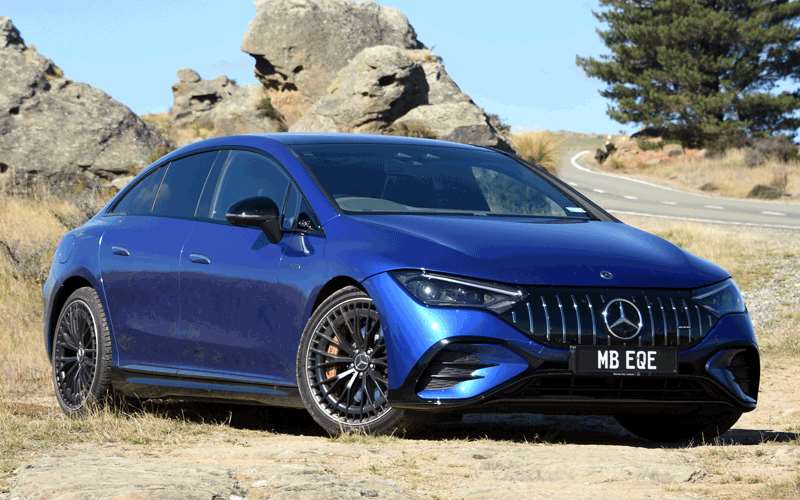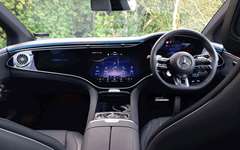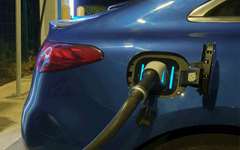Mercedes-Benz New Zealand has recently added a fifth model to its all-electric EQ line-up, and David Thomson has been putting it to the test.
What’s new?
Slotting in between the Mercedes-Benz EQC — the 2020 New Zealand Car of the Year — and the flagship EQS — a finalist for last year’s award — the new EQE model positions as a premium executive saloon; an all-electric alternative to the company’s long-running E-Class saloon, and a likely rival to the Tesla Model S and BMW i4.
Unlike its smaller siblings, the EQA, EQB and EQC, the EQE is built on a platform that has been developed exclusively for electric vehicle use. Dubbed EVA (Electric Vehicle Architecture), this platform made its debut here on the large and ultra-luxurious EQS. It is deployed in a shorter wheelbase guise for the EQE (3120mm rather than 3210mm), and the EQE is some 270mm shorter overall too.
Prices open at $132,100 for the EQE 300. Even this entry-level model features an 89kWh battery, powering the rear wheels via a 180kW/550Nm electric motor. The EQE 300 has an excellent range, likely to be about 500km in real-world highway conditions.
Listing at $145,000, the EQE 350 4MATIC has a slightly higher capacity 90.6kWh battery, and dual electric motors with a total output of 215kW/765Nm to drive all four wheels. It has a likely real-world highway range of 450-475km.
The EQE flagship is the Mercedes-AMG EQE 53 4MATIC+. Fettled by the Mercedes AMG performance arm, and wearing a $195,000 sticker, this variant deploys a 460kW/950Nm dual-motor system, and boasts a 0-100kmh sprint time of just 3.5 secs. It packs the same capacity battery as the EQE 350, with a range likely to be around 20km less.
What’s it look like?
Following a similar approach to the EQS, the EQE is proportioned quite differently to its closest conventional sibling, the E-Class. With no space for an internal combustion engine needed up front, but plenty of room between the front and rear wheels required for the battery array, the EQE’s got a long wheelbase relative to total length, and something of a snub-nose.
Visual similarities to the EQS are striking, with a swooping futuristic look that is both eye-catching and designed to optimise aerodynamic efficiency. Key differences are shorter overhangs front-and-rear and more obviously recessed flanks.
There’s plenty of clever detailing too: door handles that sit flush with the bodywork when not required; and, because the front bonnet does not open, a pop-out flap just above the front-left wheel to top-up the windscreen wiper fluid.
Being the AMG-developed flagship variant, the test car featured extra exterior bling including AMG badging and 21-inch matt-black alloy wheels. Normally red brake callipers would be nestling behind those wheels, but on the test car they were orange, signalling the presence of composite ceramic high-performance brakes.
What’s it like inside?
The long wheelbase of the EQE is a big plus when it comes to interior legroom. Shoulder room too is excellent, although the plunging roof line impinges on head room in the rear of the cabin.
Up front, there’s a lavish presentation of digital interfaces, with the Hyperscreen console spanning almost the full width of the dash. A $15,600 extra cost option, this console melds the fully digital instrument cluster and portrait-format centre touchscreen with a further passenger-side touchscreen that is an additional interface point for key functions.
Flanked on either side by turbine-like air vents, this setup is Stuttgart’s riposte to a certain Silicon Valley-based car maker in the digital domain. Like that rival’s tech-suite, it mixes some innovations that are genuinely useful, with others that are unnecessarily complex, or seem like solutions in search of problem.
Familiarity is most quickly achieved by activating smartphone mirroring, to gain access to the Android or Apple interface of your day-to-day mobile device. Even then, you’ll be wanting to download the special Mercedes Me app to make full use of what is on offer.
Expect to invest several hours to master the Mercedesprovided digital systems, and be prepared to make use of the ‘‘Hi Mercedes’’ voice command system too.
Cherry-picking from a range of features tried on test, it was well cool to receive on request a current weather report for any of the major towns and cities of the world, but ultimately that’s a bit of gimmick. More practically, setting local destinations on the sat nav was easy using voice command. On the other hand, while the sound system was superb, it took ages to figure out how to change the audio source, even in the company of a friend who is a seasoned IT professional.
Exploration of the EQE’s digital interfaces took place in a cabin garnished with LED strip lights (colour adjustable, of course), and burnished metal and carbon highlights within an overall colour scheme of charcoals and blacks.
While the futuristic look of the cabin is smart, many of the surfaces — the main screens included — have glossy finishes that are smudge prone, and reflective in direct sunlight. The interior also lacks some of the hallmark plushness of a high-end Mercedes car, due in part to the laudable use of recycled materials.
Stowage-wise, a good range of cubbies are provided with the cabin. The 430-litre boot capacity is. however, well shy of what’s provided on a conventional E-Class saloon.
What comes as standard?
The comprehensive comfort and safety packages that are standard across the EQE line are augmented on this flagship variant with an advanced vehicle protection system, AMG-accented nappa leather upholstery, full climatic (heated and chilled) front seats, a sophisticated climate control system, adaptive air-suspension, and four-wheel steering.
As noted earlier, the test car also swapped out the standard AMG brakes for ceramic composite brakes and features the MBUX Hyperscreen set-up. These options, along with some more minor options, lifted its price from the standard AMG 55’s $195,00 tag to a hefty $221,800.
What’s it like to drive?
The ultimate performance iteration of the EQE 55 is secured by adding the Dynamic Plus pack. This delivers a race-start mode that temporarily boosts power and torque to enable a 0-100 sprint in 3.2 secs (rather than the usual 3.5 secs) and raises the car’s maximum speed from 220kmh to 240kmh.
Even as tested though, the EQE flagship is a mighty performance machine. While its sporting reflexes (including an increased rear-drive bias to power delivery) are more pronounced in sport and sport plus drive modes, it is also rapid and accomplished in comfort mode.
The turbine-like smoothness of the dual electric motor power delivery is especially impressive off the mark, but stab on the accelerator at any speed and the motors will respond instantly.
An artificial noise generator can be activated to add an aural dimension to acceleration. Thankfully it does not seek to mimic a petrol engine, instead imparting a sci-fi style spaceship whir. To my mind, though, this effect is just a panacea for folk transitioning to electric cars as the EQE 55’s performance is all the more impressive when it is silent.
On the other hand, accelerating in ‘‘silent mode’’ can be hazardous, as it is very easy to lose track of how much speed has been gained in very little time.
Objectively, the EQE handles superbly for a car of it size and considerable (2600kg) weight. Much of its mass is in the battery pack, located low and within the wheelbase, and with an excellent chassis and suspension it corners with minimum body roll as if on rails, especially through medium to fast sweeping bends.
However, the driving experience is dulled by the steering, which lacks some feel and weight. This can leave the driver feeling remote from the road during press-on driving and — compounded by the rear-wheel steer input — inclined to apply more initial lock than is needed.
Selectable via paddle shifts in the usual way, the regenerative braking is excellent. With so much regenerative braking available simply by lifting off the throttle, the case for taking the ceramic brake option is weak, good as those discs are.
Shifting from a focus on the EQE 55 as a performance car to a luxury cruiser, it excels in delivering fine ride even on poor surfaces, especially in comfort mode. Tyre roar aside, noise levels are also muted.
Ease of electric motoring?
Drive the EQE 55 gently and its 90.6kWh battery will enable a real-world highway range comfortably beyond 400km. Succumb to its AMG-provided performance temptations, though, and available range will plummet massively.
There’s a handy function within the navigation system that alerts you to the nearest EV charge point when the battery starts running low. As well being fully compatible with the current network of mainly 50kW rapid chargers, the EQE will charge must faster with the next generation of ‘‘superchargers,’’ at powers of up to 170kW.
Larger-capacity batteries, of course, take more time to charge to a given percentage of full than the smaller ones. As far as home charging is concerned, a consequence is that trickle charging via a regular three-pin plug has limited value; anyone looking to own an EQE will want to install a higher capacity wall box.
On public 50kWh chargers, you will win no friends in the EV community by plugging in for the 90 minutes needed to lift the EQE 55’s battery charge from 10 percent to 80 percent. Commercial charging time concerns will diminish once superchargers are more widely deployed, with just 30 minutes needed for the same power boost off a 150kW charger.
Verdict
The EQE 55 left me in the odd position of feeling both hugely impressed and slightly disappointed.
Hugely impressed because the car is a brilliant piece of engineering. It easily matches Tesla in the digital realm and is remarkable in its blending of high performance, luxury and comfort attributes.
A trifle disappointed because the EQE 55 carries the badge of AMG, which is Mercedes’ ultimate expression of driving excitement. Nailing the AMG colours to the EV mast is a challenge, and thoroughly executed as it is, as an AMG machine it does not fully hit the mark.












